From the Trenches
A Lost Sock's Secrets
By ERIC A. POWELL
Monday, December 10, 2018
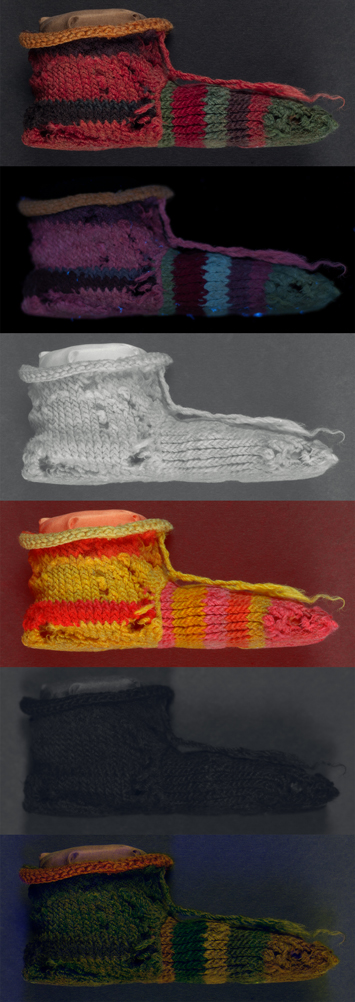 Still vibrant after 1,700 years, a child’s striped left sock is providing evidence of just how subtly dyers plied their craft in Roman-era Egypt. Unearthed in 1913 in a trash heap at the site of Antinopolis, a city founded by the emperor Hadrian, the woolen sock is one of four ancient Egyptian textiles recently studied by a team led by British Museum chemist Joanne Dyer. She and her colleagues examined the artifacts, which also included fragments of decorated wool tapestries, with an array of imaging techniques that exposed the textiles to different wavelengths of light. These techniques have previously been used to analyze painted surfaces. The different light sources allowed the team to determine the chemistry of the dyes used to color the textiles without having to remove samples that might damage the artifacts. They found that just three natural colorants—indigo, the herb madder, and the weld plant—created the sock’s exuberant stripes. “What’s surprising is that while the textiles are highly colored and very varied, the ancient Egyptians used only a few natural dyes to create this extensive palette,” says Dyer. Despite scant resources, a skillful dyer was able to make a stripy sock that wouldn’t look out of place on a playground today.
Still vibrant after 1,700 years, a child’s striped left sock is providing evidence of just how subtly dyers plied their craft in Roman-era Egypt. Unearthed in 1913 in a trash heap at the site of Antinopolis, a city founded by the emperor Hadrian, the woolen sock is one of four ancient Egyptian textiles recently studied by a team led by British Museum chemist Joanne Dyer. She and her colleagues examined the artifacts, which also included fragments of decorated wool tapestries, with an array of imaging techniques that exposed the textiles to different wavelengths of light. These techniques have previously been used to analyze painted surfaces. The different light sources allowed the team to determine the chemistry of the dyes used to color the textiles without having to remove samples that might damage the artifacts. They found that just three natural colorants—indigo, the herb madder, and the weld plant—created the sock’s exuberant stripes. “What’s surprising is that while the textiles are highly colored and very varied, the ancient Egyptians used only a few natural dyes to create this extensive palette,” says Dyer. Despite scant resources, a skillful dyer was able to make a stripy sock that wouldn’t look out of place on a playground today.
Raise a Toast to the Aurochs
By ZACH ZORICH
Monday, December 10, 2018
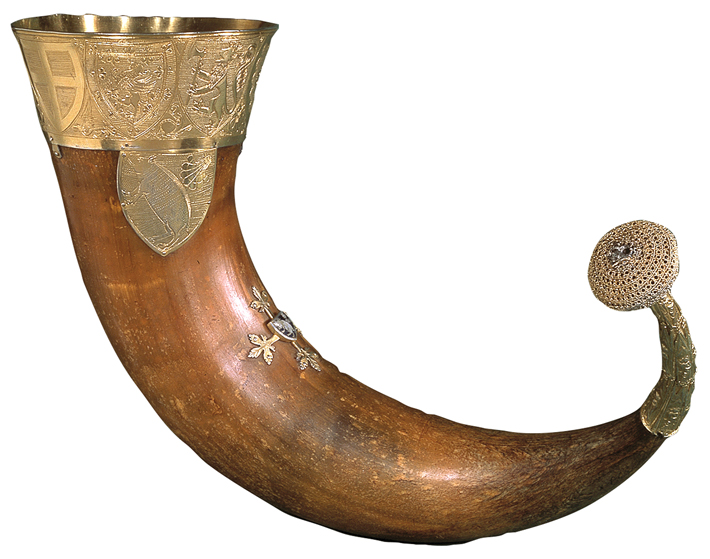 The last aurochs, the wild ancestor of domesticated cattle and a favorite game animal up to the medieval period in Europe, died at a game preserve in Poland in 1627. Now a group of Scandinavian researchers are searching for the long-lost bovine’s genetic signature in medieval drinking horns. For the better part of the Middle Ages, well-heeled noblemen preferred to quaff their beverages from the horns of bulls—and the bigger the horn the better. In fact, this may have been a contributing factor to the aurochs’ extinction. The researchers examined mitochondrial DNA that they had recovered from five medieval drinking horns. Mitochondrial DNA (mtDNA) is inherited from the mother’s side. They also looked at the horn of the last bull aurochs. Three of the drinking horns contained aurochs mtDNA, but two drinking horns and the horn of the last bull aurochs showed mtDNA from domestic cattle as well. This may be evidence of interbreeding between the two species. Future work will focus on recovering the rest of the aurochs genome.
The last aurochs, the wild ancestor of domesticated cattle and a favorite game animal up to the medieval period in Europe, died at a game preserve in Poland in 1627. Now a group of Scandinavian researchers are searching for the long-lost bovine’s genetic signature in medieval drinking horns. For the better part of the Middle Ages, well-heeled noblemen preferred to quaff their beverages from the horns of bulls—and the bigger the horn the better. In fact, this may have been a contributing factor to the aurochs’ extinction. The researchers examined mitochondrial DNA that they had recovered from five medieval drinking horns. Mitochondrial DNA (mtDNA) is inherited from the mother’s side. They also looked at the horn of the last bull aurochs. Three of the drinking horns contained aurochs mtDNA, but two drinking horns and the horn of the last bull aurochs showed mtDNA from domestic cattle as well. This may be evidence of interbreeding between the two species. Future work will focus on recovering the rest of the aurochs genome.
Funny Business
By MARLEY BROWN
Monday, December 10, 2018
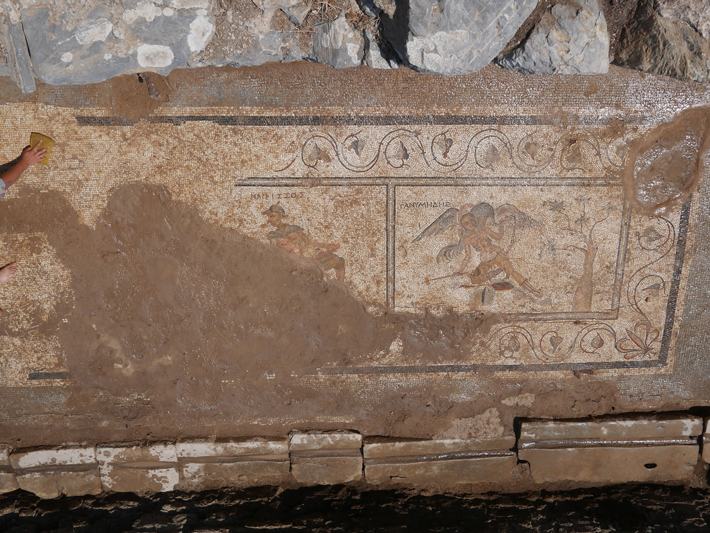 A public latrine used by ancient patrons of a large bathhouse and government officials who worked nearby is the setting for a recently discovered, somewhat bawdy mosaic. A team from the University of Nebraska had been excavating the site of the city of Antiochia ad Cragum on the south coast of Turkey for more than a decade when they uncovered the second-century A.D. mosaic, which features humorous takes on famous Greek myths. One panel portrays Narcissus, the boy who fell in love with his own reflected image. Here he is infatuated with a rather more intimate part of his anatomy. Another panel shows Ganymede, cupbearer to the gods, offering up the ancient version of toilet paper. Project leader Michael Hoff explains that Romans weren’t squeamish about depicting bodily functions and sexuality. “One only has to visit the houses of Pompeii to see that images of sex and nudity were commonplace and visible to all, regardless of gender or status in society,” he says. Hoff adds that while the majority of Antiochia ad Cragum’s residents were not of Greek or Latin heritage, the mosaic demonstrates that Greek myths were almost universally understood in the far-reaching Mediterranean world.
A public latrine used by ancient patrons of a large bathhouse and government officials who worked nearby is the setting for a recently discovered, somewhat bawdy mosaic. A team from the University of Nebraska had been excavating the site of the city of Antiochia ad Cragum on the south coast of Turkey for more than a decade when they uncovered the second-century A.D. mosaic, which features humorous takes on famous Greek myths. One panel portrays Narcissus, the boy who fell in love with his own reflected image. Here he is infatuated with a rather more intimate part of his anatomy. Another panel shows Ganymede, cupbearer to the gods, offering up the ancient version of toilet paper. Project leader Michael Hoff explains that Romans weren’t squeamish about depicting bodily functions and sexuality. “One only has to visit the houses of Pompeii to see that images of sex and nudity were commonplace and visible to all, regardless of gender or status in society,” he says. Hoff adds that while the majority of Antiochia ad Cragum’s residents were not of Greek or Latin heritage, the mosaic demonstrates that Greek myths were almost universally understood in the far-reaching Mediterranean world.
Double Vision
By GURVINDER SINGH
Monday, December 10, 2018
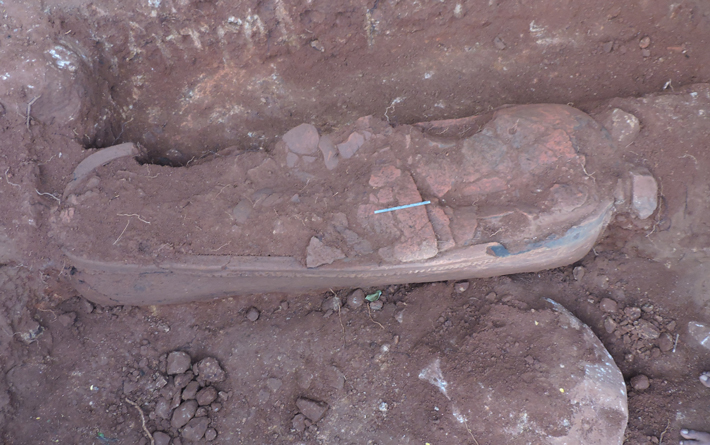 A team of archaeologists in southern India has unearthed an approximately 2,300-year-old terracotta sarcophagus in Pallavaram, located 15 miles from the city of Chennai. “The nearly intact, handmade, oblong coffin is an important discovery,” says A.M.V. Subramanyam, superintending archaeologist of the Archaeological Survey of India (ASI) in Chennai. An almost identical sarcophagus was found 130 years ago in the same area. The 1888 find was the first artifact to establish the existence of a distinctive Iron Age culture in this region. Researchers from the ASI will soon perform thermoluminescence dating to determine the sarcophagus’ exact age.
A team of archaeologists in southern India has unearthed an approximately 2,300-year-old terracotta sarcophagus in Pallavaram, located 15 miles from the city of Chennai. “The nearly intact, handmade, oblong coffin is an important discovery,” says A.M.V. Subramanyam, superintending archaeologist of the Archaeological Survey of India (ASI) in Chennai. An almost identical sarcophagus was found 130 years ago in the same area. The 1888 find was the first artifact to establish the existence of a distinctive Iron Age culture in this region. Researchers from the ASI will soon perform thermoluminescence dating to determine the sarcophagus’ exact age.
When Things Got Cheesy
By ZACH ZORICH
Monday, December 10, 2018
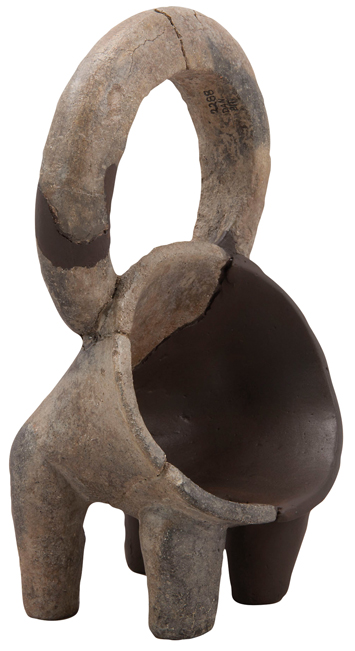 Some of the earliest evidence of cheese making has been identified on pottery found on the Dalmatian coast of Croatia. A multinational team of archaeologists and chemists analyzed fatty-acid residues dating to the Middle Neolithic period, about 7,200 years ago. Evidence of cheese making dating to roughly the same period has also been found in Poland. At that time, milk production was already an established practice, but fermenting raw milk into cheese may have provided an additional survival advantage. Children who have been weaned from their mother’s milk are particularly vulnerable to malnutrition. As they age, they gradually lose the ability to digest the milk sugar lactose. Fermenting milk into cheese reduces its lactose content, while still providing a rich source of calories. The team also found that specific pottery shapes were associated with cheese production, including sieves and a type of footed pot with an opening on its side.
Some of the earliest evidence of cheese making has been identified on pottery found on the Dalmatian coast of Croatia. A multinational team of archaeologists and chemists analyzed fatty-acid residues dating to the Middle Neolithic period, about 7,200 years ago. Evidence of cheese making dating to roughly the same period has also been found in Poland. At that time, milk production was already an established practice, but fermenting raw milk into cheese may have provided an additional survival advantage. Children who have been weaned from their mother’s milk are particularly vulnerable to malnutrition. As they age, they gradually lose the ability to digest the milk sugar lactose. Fermenting milk into cheese reduces its lactose content, while still providing a rich source of calories. The team also found that specific pottery shapes were associated with cheese production, including sieves and a type of footed pot with an opening on its side.
Advertisement
Advertisement
IN THIS ISSUE
From the Trenches
The Case of the Stolen Sumerian Antiquities
Off the Grid
Ancient Amazonian Chocolatiers
Fit for a Prince
When Things Got Cheesy
Funny Business
Double Vision
Raise a Toast to the Aurochs
A Lost Sock's Secrets
Land of the Ice and Snow
Bath Tiles
India's Anonymous Artists
No Rainbow Required
Passage to the Afterlife
World Roundup
Scottish clan memorabilia, a conquistador shrine, Neolithic nutmeg, Maya sea salt harvesters, and a Chinese model house
Artifact
Heirloom apparent
Advertisement

Recent Issues
-
 May/June 2024
May/June 2024
-
 March/April 2024
March/April 2024
-
 January/February 2024
January/February 2024
-
 November/December 2023
November/December 2023
-
 September/October 2023
September/October 2023
-
 July/August 2023
July/August 2023
-
 May/June 2023
May/June 2023
-
 March/April 2023
March/April 2023
-
 January/February 2023
January/February 2023
-
 November/December 2022
November/December 2022
-
 September/October 2022
September/October 2022
-
 July/August 2022
July/August 2022
-
 May/June 2022
May/June 2022
-
 March/April 2022
March/April 2022
-
 January/February 2022
January/February 2022
-
 November/December 2021
November/December 2021
-
 September/October 2021
September/October 2021
-
 July/August 2021
July/August 2021
-
 May/June 2021
May/June 2021
-
 March/April 2021
March/April 2021
-
 January/February 2021
January/February 2021
-
 November/December 2020
November/December 2020
-
 September/October 2020
September/October 2020
-
 July/August 2020
July/August 2020
-
 May/June 2020
May/June 2020
-
 March/April 2020
March/April 2020
-
 January/February 2020
January/February 2020
-
 November/December 2019
November/December 2019
-
 September/October 2019
September/October 2019
-
 July/August 2019
July/August 2019
-
 May/June 2019
May/June 2019
-
 March/April 2019
March/April 2019
-
 January/February 2019
January/February 2019
-
 November/December 2018
November/December 2018
-
 September/October 2018
September/October 2018
-
 July/August 2018
July/August 2018
-
 May/June 2018
May/June 2018
-
 March/April 2018
March/April 2018
-
 January/February 2018
January/February 2018
-
 November/December 2017
November/December 2017
-
 September/October 2017
September/October 2017
-
 July/August 2017
July/August 2017
-
 May/June 2017
May/June 2017
-
 March/April 2017
March/April 2017
-
 January/February 2017
January/February 2017
-
 November/December 2016
November/December 2016
-
 September/October 2016
September/October 2016
-
 July/August 2016
July/August 2016
-
 May/June 2016
May/June 2016
-
 March/April 2016
March/April 2016
-
 January/February 2016
January/February 2016
-
 November/December 2015
November/December 2015
-
 September/October 2015
September/October 2015
-
 July/August 2015
July/August 2015
-
 May/June 2015
May/June 2015
-
 March/April 2015
March/April 2015
-
 January/February 2015
January/February 2015
-
 November/December 2014
November/December 2014
-
 September/October 2014
September/October 2014
-
 July/August 2014
July/August 2014
-
 May/June 2014
May/June 2014
-
 March/April 2014
March/April 2014
-
 January/February 2014
January/February 2014
-
 November/December 2013
November/December 2013
-
 September/October 2013
September/October 2013
-
 July/August 2013
July/August 2013
-
 May/June 2013
May/June 2013
-
 March/April 2013
March/April 2013
-
 January/February 2013
January/February 2013
-
 November/December 2012
November/December 2012
-
 September/October 2012
September/October 2012
-
 July/August 2012
July/August 2012
-
 May/June 2012
May/June 2012
-
 March/April 2012
March/April 2012
-
 January/February 2012
January/February 2012
-
 November/December 2011
November/December 2011
-
 September/October 2011
September/October 2011
-
 July/August 2011
July/August 2011
-
 May/June 2011
May/June 2011
-
 March/April 2011
March/April 2011
-
 January/February 2011
January/February 2011
Advertisement






